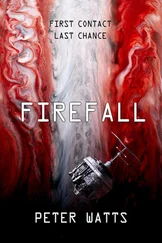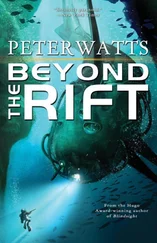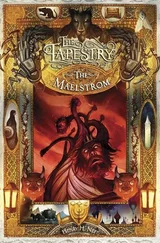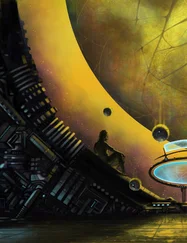Evidently, you burned it.
He tapped his console. "Hey, Alice."
Her image flashed onto a window, upper-left. "Right here."
"Give me something."
"Can't yet," she said. "Not carved in stone."
"Balsa will do. Anything."
"It's small. Maybe two hundred, three hundred nanometers. Relies heavily on sulfur compounds, structurally at least. Very stripped-down genotype; I think it may use RNA for both catalysis and replication, which is a really neat trick. Built for a simple ecosystem, which makes sense if it's a construct. They never expected it to get out of culture."
"But what does it do ?"
"Can't say. I'm working with a frog in a blender here, Killjoy. You should actually be kind of impressed that I've gotten as far as I have. You ask me, it's pretty obvious we're not supposed to figure out what it does."
"Could it be some kind of really nasty pathogen?" It has to be. It has to be. If we're burning people ,—
"No." Her voice was flat and emphatic. " We are not. They are."
Desjardins blinked. I said that? "We're all on the same side, Alice."
"Uh-huh."
"Alice…" Sometimes she really pissed him off. There's a war going on , he wanted to shout. And it's not against corpses or bureaucrats or your imaginary Evil Empires; we're fighting against a whole indifferent universe that's coming down around our ears and you're shitting on me because sometimes we have to accept casualties?
But Alice Jovellanos had a blind spot the size of Antarctica. Sometimes you just couldn't reason with her. "Just answer the question, okay? Someone obviously thinks this thing is extremely dangerous. Could it be some kind of disease?"
"Biowar agent, you mean." Surprisingly, though, she shook her head. "Unlikely."
"How come?"
"Diseases are just little predators that eat you from the inside. If they're designed to feed on your molecules, their biochemistry should be compatible with yours. The D-aminos suggest they're not."
"Only suggest?"
Jovellanos shrugged. "Frog in a blender, remember? All I'm saying is if A is gonna eat B without throwing up, they should have similar biochemistries. ßehemoth just seems a little too far into the Oort to qualify. I could be wrong."
But the vectors—shipbuilders, divers— "Could it survive in a human host, at least?"
She pursed her lips. "Anything's possible. Look at A-51."
"What's that?"
"Metal-oxidizing microbe. Sediment-dweller from deep lakes, only there's a few million of them living in your mouth right now. Nobody knows how they got there exactly, but there you go."
Desjardins steepled his fingers. "She called it a soil microbe," he murmured, almost to himself.
"She'd call it corn on the cob if she thought it'd cover her corporate ass."
"Jeez, Alice." He shook his head. "Why do you even work here, if all we do is serve some evil overlord?"
"Everyone else is worse."
"Well, I don't think ßehemoth came out of a pharm. I think it came from the ocean."
"How so?"
"The fires correlate with people who spent a lot of time at sea."
"Ocean's a pretty big place, Killjoy. Seems to me if it was a natural bug it would have come ashore millions of years ago."
"Yeah." Desjardins linked to the personnel files for each of the relevant victims— sparing a moment of silent thanks for the devil's bargain that had traded free will for security clearance — and started narrowing the field.
"Although, now that you mention it," Jovellanos went on, "those superstiff enzymes would work better in a high-pressure environment."
A menu, a couple of tapped commands: a convex projection of the North Pacific extruded from the board.
"And if this little bastard isn't a construct, then it's older than old. Even before Martian Mike—hey, maybe it actually originated here, wouldn't that be something?"
Desjardins draped a GIS mesh across the map and poured data onto it. Luminous points spilled across the display like radioactive contrails in a cloud chamber: the cumulative Pacific assignments of the seagoing victims, sorted on location.
"Hey, Killjoy."
The points were piling up disproportionately at several key locations; seafarms, mining outposts, the trans-oceanic filaments of shipping routes. Nothing unusual there.
"Hellooo?" In her window, Jovellanos's head bobbed impatiently back and forth.
Let's cut to the chase, shall we? Any spots where all these people hung out at the same time over the past…say, two years…
At the edge of awareness, Alice Jovellanos grumbled about attention deficit disorder and disconnected.
Desjardins barely noticed. The Pacific Ocean had gone utterly dark, but for a single cluster of points. Southern tip of the Juan de Fuca Ridge. Channer Vent, said the legend.
A geothermal generating station. Place called Beebe .
* * *
There'd been deaths there, too. But not by fire; according to the record, everyone at Beebe had been killed by the quake.
In fact—Desjardins pulled up a seismic overlay—Beebe Station had pretty much been at the exact epicenter of the quake that had triggered the Big One…
ßehemoth comes from the bottom of the ocean. It was down in the vents there, or trapped in the moho and then the quake let it out, and now they're running around like a bunch of adrenocorticoids trying to burn out anything that came in contact with—
No, wait a second—
More commands. The data cloud dispersed, re-formed into a column sorted against time; a luminous date appeared beside each point.
Almost all of the firestorm activity had taken place before the quake.
Desjardins called up a subset containing only fires at industrial sites, cross-linked with GA invoices. Quelle surprise : every site belonged to a company that had had a piece of Beebe's construction contact.
This thing got out before the Quake.
Which meant the Quake might not have been a natural disaster at all. It might have been mere side-effect. Collateral damage during containment.
Apparently, unsuccessful containment.
He called up every seismic database within Haven's walls. He stuffed a thousand messages into bottles and threw them out into Maelstrom, hoping some would wash ashore at a technical library or a satcam archive or an industrial surveillance site. He opened dedicated links to the seismic centers at UBC and Melbourne and CalTech. He watched reams of garbage accumulate— archives purged to reclaim memory, data dumped due to low demand, this address corrupted, do not attempt access . He passed the shouts and echoes and gibberish through a dozen filters, dropped signal and looked only at residuals, ran into gaps and interpolated bridges.
He looked at seismic data immediately preceding the Quake, and found nothing untoward: no subsidence, no preshocks, no changes in microgravity or ocean depth. None of the little telltales that usually portend a seismic event.
Odd.
He searched archives for satcam visuals. Nothing over the North Pacific seemed to have snapped any pictures at all that day.
Odder. In fact, virtually inconceivable.
He widened the scope, stretched it from the Eastern Tropical Convergence up to the Bering. One hit: an Earthsat in polar orbit had just been coming over the 451 horizon when the first shockwaves had registered. It had been taking pictures of the Bering on visible wavelengths; it hadn't even been looking at the Pacific. Just a lucky coincidence, then, the image it had caught from the corner of its eye: a smudged column of cloud on the horizon, rising from the ocean's surface against an otherwise cloudless background.
Читать дальше









